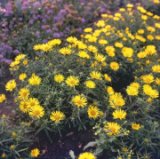 |
QUICK SEARCH
MO PROJECTS:
Africa
Asia/Pacific
Mesoamerica
North America
South America
General Taxonomy
Photo Essays
Training in Latin
America
MO RESEARCH:
Wm. L. Brown Center
Bryology
GIS
Graduate Studies
Research Experiences
for Undergraduates
Imaging Lab
Library
MBG Press
Publications
Climate Change
Catalog Fossil Plants
MO DATABASES:
W³MOST
Image Index
Rare Books
Angiosperm
Phylogeny
Res Botanica
All Databases
INFORMATION:
What's New?
People at MO
Visitor's Guide
Herbarium
Jobs & Fellowships
Symposium
Research Links
Site Map
Search
ORNAMENTAL PLANTS OF HORTICULTURE VALUESelection of perennials
European Russia (central and southern regions), Caucasus (northern Caucasus, Dagestan, northern Transcaucasus). On dry grassy slopes among shrubs. Rhizome horizontal, short. Stems 60-70 cm, branched in the upper part, densely pubescent. Lower leaves almost round, upper lanceolate with petiole up to 10 cm. Heads many-flowered. Flowers blue or pinkish-blue. V - mid spring to late autumn. Fl - late summer to late autumn, August to October in the wild. Fr - October, November. P - by seed or division. Prefers sunny place, semi-shade tolerant. Recommended for group planting. Z 6 (5). New. A. ibericus Stev. Caucasus (Transcaucasus, Dagestan). In mountain meadows and open deciduous forests. Rhizomes horizontal, long and relatively thin. Stems 20-80 cm, erect, branched, rough-hairy. Basal leaves broadly lanceolate, tapered into a long petiole, entire or occasionally toothed. Upper leaves sessile with an entire margin. Flower heads large, 5 cm or more diam., in a loose corymb. Ray flowers numerous, large (13-15 mm), blue or pink. V - May to October. Fl - in nature August-September. Fr. - October. P - by seed or division. Z 6 (5). New. A. spathulifolius Maxim. (A. fauriei Levl. et Vaniot) Far East (Sakhalin). In moist meadows near the sea shore. Rhizome branched. Stems erect, 120-150 cm, glabrous at the base, branched only in the flowering shoots. Basal leaves very large, up to 50 cm long, withering before the flowering period. Stem leaves 10-20 cm, elongated-oblong, those on the flowering shoots sessile. Flower heads numerous, 30 to 50, each 4-5 cm diam. Ray flowers lilac, disc flowers yellow. V - mid spring to late autumn. Fl - in wild August-September. Fr - October. Propagated by seed or division. Requires a sunny position and good soil. Z 5. New. |
|||
| SELECTION OF PERENNIALS |
© 1995-2025 Missouri Botanical Garden, All Rights Reserved
4344 Shaw Blvd.
St. Louis, MO 63110
(314) 577-5100
Technical Support
